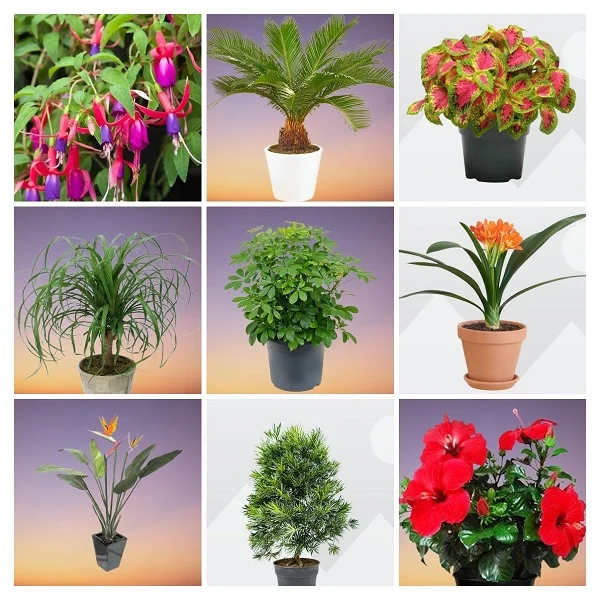17 Monstera Varieties You May Add to Your Collection with Names and Pictures
Some links in this post may be affiliate links
Monstera Plant Varieties are evergreen plants which can climb to heights of more than 60 feet on tree branches by means of aerial roots which act as hooks by attaching to the tree bark.
The aerial roots also grow into the soil to support the plant and keep it upright. Therefore, Monstera are considered as hemiepiphyte because the plant roots both into the soil and over trees.
The leaves in Monstera Plants are alternate, leathery, dark green, very large (in some species), broad, often with holes (fenestrations) in the leaf blade.
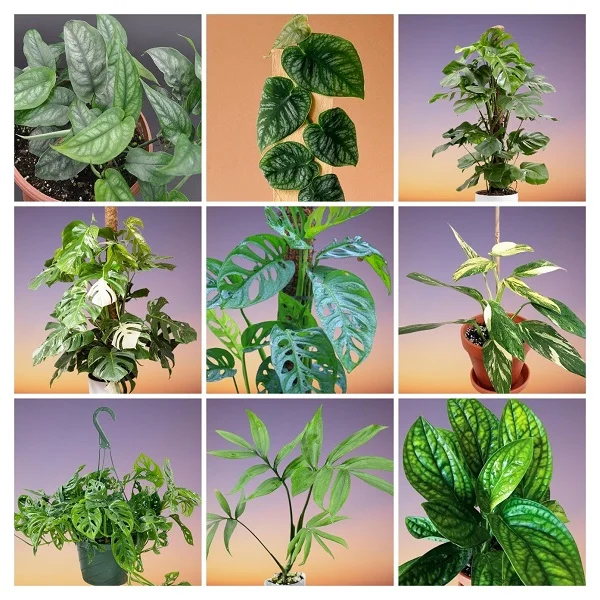
These fenestratrations allow the leaves to spread over greater area to increase sunlight exposure, and to allow light to reach other leaves below.
Monstera flowers like in other Aroids are borne on a specialised inflorescence known as a spadix while the fruit is a cluster of white berries which is edible in some species.
The genus is named, 'Monstera', is Latin for 'monstrous' or 'abnormal', in reference to the unusual leaves with natural holes which some species exhibit.
There are about 59 species in the Monstera Genus which belong to the Araceae Family and are native to the tropical regions of the Americas. On account of their spectacular leaves, interesting growth habits and ease of care, Monstera are popular plants.
If you are looking to add Monsteras to your collection, we have herebelow outlined for you 17 of the most popular Monstera varieties that you can easily grow in the home or office space.
17 Monstera Varieties for Your Home
Popular Monstera Varieties include Monstera deliciosa, Monstera dubia, Monstera siltepecana, Monstera standleyana, Monstera Peru, Monstera Burle Marx Flame, Monstera adansonii among others.
1. Monstera deliciosa (Swiss Cheese Plant)

Swiss Cheese Plant also called Split Leaf Philodendron, Monster Fruit, Mexican Breadfruit or Windowleaf Plant is a popular plant whose large deeply perforated leaves are a sight to behold and is easy to grow even for a beginner.
Swiss Cheese Plant is among the fast-growing plants and can grow to a height of 20 feet or more when given a moss pole and the right growing conditions.
Monstera deliciosa prospers in medium to bright indirect light, average warmth of 18-290C, humidity of 50-55% and moderately moist, fertile, well-drained, Monsteras potting soil coupled with monthly feeding during the growing season.
Learn more on how to grow and care for Monstera deliciosa (Swiss Cheese Plant)
2. Monstera adansonii (Adanson's Monstera)
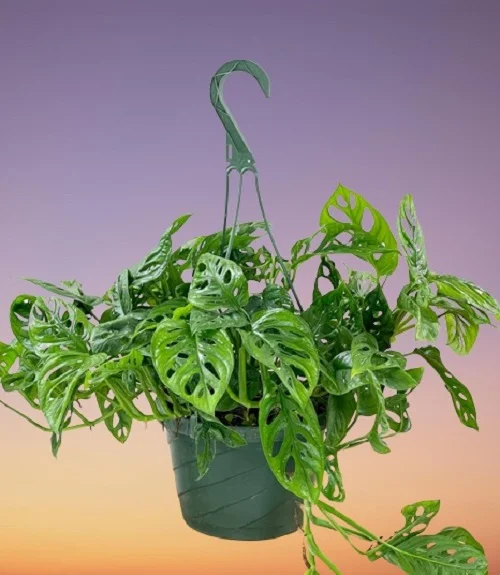
Adanson's Monstera also called Swiss Cheese Vine or Monkey Mask Plant bears glossy, long, ovate, light-green-colored, perforated leaves.
In the juvenille stage the stems exhibit a creeping habit, have short internodes while the leaves may be entire or perforated when only 5-10 cm long.
Adanson's Monstera stems can grow to a length of 13 feet and can be grown as a climber or in a hanging basket making it is one of the best low-light plants for an office desk without sunlight.
Monstera adansonii grows best in medium to bright indirect light, average warmth of 17-290C, humidity of 50-55% and moderately moist, fertile, well-drained, Monstera potting soil coupled with monthly feeding during the growing period.
Read more on how to grow and care for Monstera adansonii (Adanson's Monstera)
3. Monstera adansonii 'Albo-Variegata'

Monstera adansonii 'Albo-Variegata' is a rare variegated version of the Monstera adansonii which bears glossy leaves with two tones of green and cream.
Variegated Monstera adansonii requires more light than the green variety as it has less chlorophyll due to the variegation.
To enhance color, grow Monstera adansonii 'Albo-Variegata' in bright bright indirect light away from direct sunlight, average warmth, above average humid conditions and moderately moist, rich, well-drained soil.
4. Monstera dubia
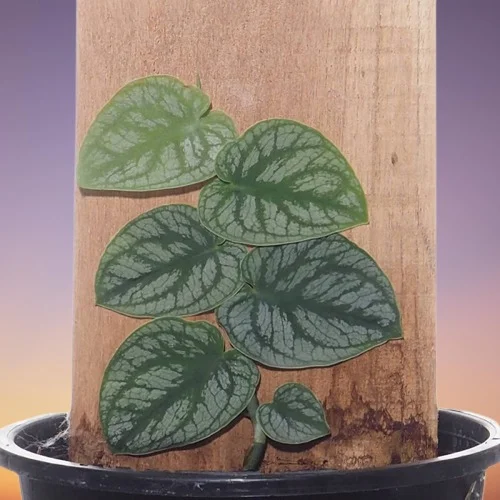
Monstera dubia is an evergreen vine which exhibits three different forms in its life stages; young leaves have a green base and silvery-grey variegation between dark-green veins, as they age they develop small holes and eventually produce large, green, fenestrated mature leaves similar to those of Monstera deliciosa.
Monstera dubia has a high tolerance to shade conditions which places it among the best low-light plants perfect for any space in the home or office.
Monstera dubia thrives in medium to bright indirect light (filtered light), average warmth of 18-290C, moderate humidity of 50-55% and moderately moist, rich, well-drained, Monstera potting mix coupled with monthly feeding during the growing season.
Learn more on how to grow and care for Monstera dubia
5. Monstera standleyana (Five Holes Plant)
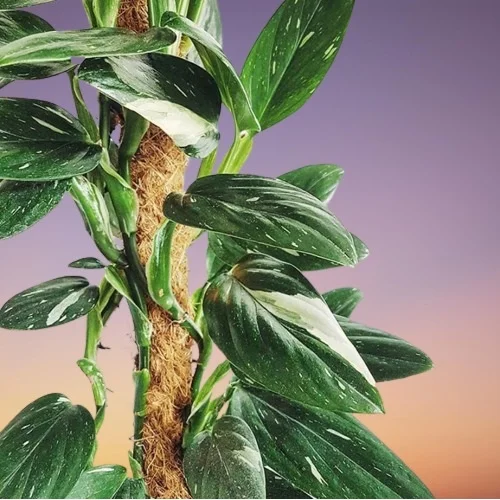
Monstera standleyana bears upright, oval, dark-green leaves which are striped with white and silvery speckles. Each leaf has a unique pattern which makes this decorative plant spectacular.
Five Holes Plant can grow to a height of 12-15 feet. It can be grown as a climber on a moss pole or on a trellis which makes it one of the best plants for the office space.
Monstera standleyana grows best in bright indirect light (filtered light), average warmth of 18-280C, moderate humidity of 50-55% and moderately moist, rich, well-drained, Monstera potting soil coupled with monthly feeding in the growing season.
Read more on how to grow and care for Monstera standleyana (Five Holes Plant)
6. Monstera siltepecana (Silver Monstera)
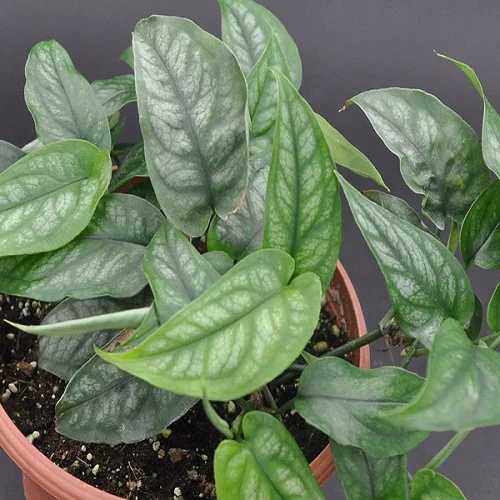
Silver Monstera also called Siltene Monstera is an evergreen vine which exhibits two different appearances in its life stages where the young leaves are bluish-gray with distinct dark-green veins and become larger, dark-green and develop fenestrations (holes) as they mature.
Siltene Monstera is often mistaken for Epipremnum-pinnatum 'Cebu Blue' Pothos. Both plants are ideal for hanging baskets making them some of the best low-light plants for limited spaces.
Monstera siltepecana blossoms in bright indirect light, average warmth of 18-270C, humidity of 50-55% and moderately moist, fertile, well-drained, Monstera potting soil coupled with monthly feeding during the growing season.
Learn more on how to grow and care for Monstera siltepecana (Silver Monstera)
7. Monstera deliciosa 'Albo-Variegata'

Monstera deliciosa 'Albo-Variegata' is a variegated version of Monstera deliciosa which bears white variegations on the large, perforated leaves and some leaves that are solidly half and half. This is a genetic mutation, which means the variegation occurs naturally.
Monstera Albo is slightly harder to grow than the green form as it requires brighter light away from direct sunlight to prevent scorching, much higher humidity and careful watering to avoid soggy soil which can cause browning of the leaves.
Monstera variegata can be propagated from stem cuttings but it may not breed true to type; the variegation on the leaves is not stable and may be lost and the plant can revert to the all green version.
8. Monstera deliciosa 'Aurea-Variegata'

Monstera deliciosa 'Aurea-Variegata' also called Monstera Marmota or Golden Monstera is another variegated version of Monstera deliciosa which bears yellow or lime variegations on dark-green, perforated leaves.
The variegation in Monstera Aurea varies from a splotchy pattern to ‘full moon’ leaves (leaves whose one half is green while the other half is yellow or cream).
To maintain the variegation, Golden Monstera requires bright light with some direct sunlight, average warm and above average humidity and moist, well-drained soil that is rich in organic matter.
9. Monstera deliciosa Thai Constellation
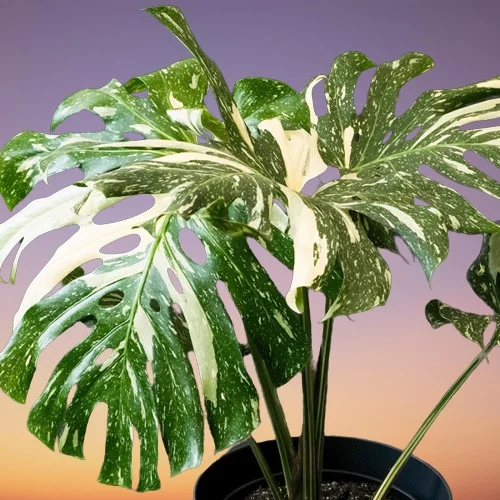
Monstera deliciosa Thai Constellation is a rare cultivar of a hybrid between Monstera deliciosa and the Epipremnum pinnatum (Dragon Tail Plant that was developed in Thailand in the late 1990s.
Monstera Thai Constellation bears cream-colored splatters on the green leaves which resemble a starry night sky and this gives it the name 'Constellation'.
Being a product of tissue culture, mass production of Monstera Thai Constellation is rather difficult and this makes the plant rare and very expensive to acquire.
10. Monstera obliqua
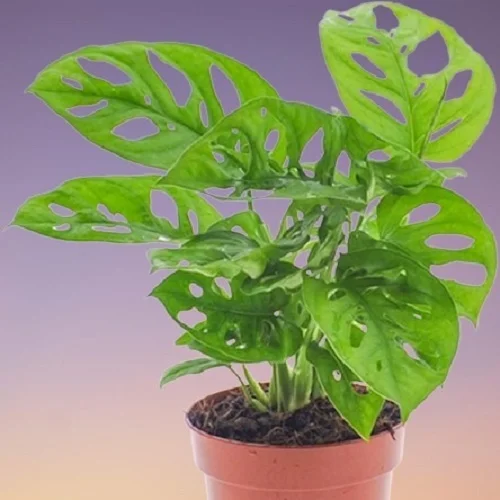
Monstera obliqua a rare plant that has highly perforated leaves and is often described as having more empty space than leaf; in mature plants, only about 10% of the leaf comprises of paper-thin strands of leaf blade.
Monstera obliqua is an extremely slow grower which requires delicate care and higher humidity than other Monstera varieties. These characteristics make this plant unsuitable for ordinary room conditions.
Monstera obliqua is perfect for growing in a terrarium, in fertile, well-drained as the warm, humid conditions it requires can be maintained inside a terrarium.
11. Monstera sp. Peru (Green Galaxy Monstera)
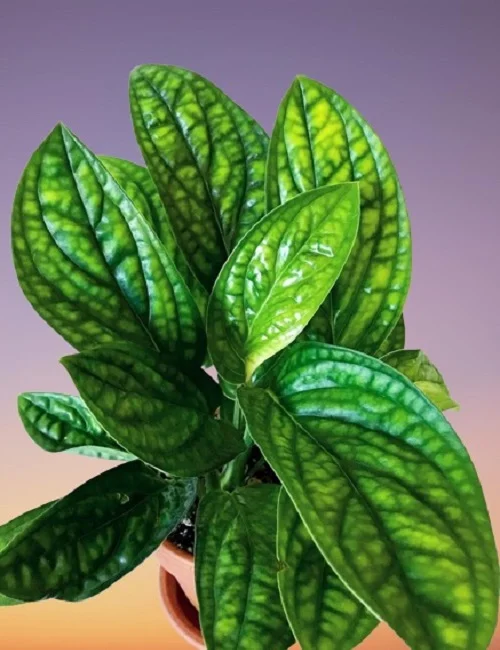
Monstera sp. Peru also called Monstera karstenianum is a fast-growing, climbing plant with thick, stiff, quilted, light-green leaves.
To enhance growth of large leaves, provide Green Galaxy Monstera with a sturdy support like a moss pole or a trellis on which it can easily climb.
Monstera Peru requires bright indirect light, warm and moderately humid conditions and moderately moist, rich, well-drained soil to thrive. Keep it away from cold drafts and hot direct sunshine to prevent scorching of the leaves.
12. Monstera pinnatipartita
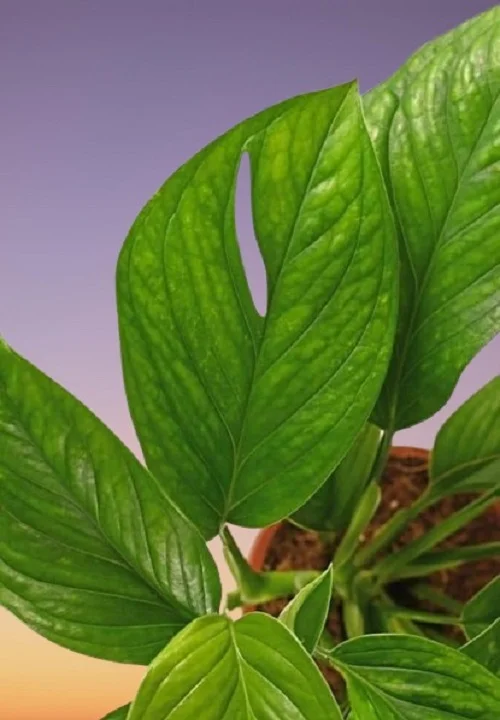
Monstera pinnatipartita resembles Monstera Peru in the early stages of development but the leaves are more elongated and as it grows the leaves begin to fenestrate unlike in the latter.
Monstera pinnatipartita is a climber which requires to be provided with some support to encourage development of large leaves as well as the fenestrations on the leaves.
For lush growth, grow Monstera pinnatipartita in bright filtered light, warm and humid conditions and evenly moist, well-drained soil that is rich in organic matter. These conditions mimick its natural habitat in the tropical rainforests of Central and South America.
13. Monstera acuminata

At a first glance, Monstera acuminata resembles Monstera adansonii but it has smoother and more puckered leaves which lie at a slight angle compared to the flat lying leaves in the latter.
In addition, the fenestrations in Monstera acuminata are smaller and fewer than in Monstera adansonii and the leaves are also a darker-green and oval-shaped.
Grow Monstera acuminata in bright indirect light, warm and humidi conditions, consistently moist, fertile, well-drained soil and provide it with a moss pole to enhance faster growth and fenestration of leaves.
14. Monstera subpinnata
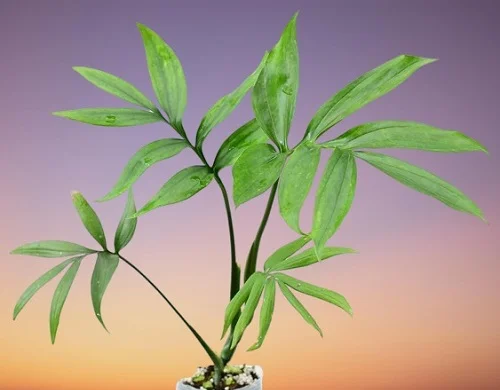
Monstera subpinnata is an epiphytic, fast-growing vine which bears alternately arranged pinnate leaves unlike other plants in the Monstera Genus.
Monstera subpinnata can grow to a height of 6 feet and 3 feet wide when provided with the right growing conditions similar to those of its natural environment in the tropical rainforests of South America.
To thrive, Monstera subpinnata requires bright filtered light, warm and humid conditions, moist, rich and well drained soil away from direct sunlight. It also needs to be given a sturdy support to hasten growth.
15. Monstera Burle Marx Flame

Monstera Burle Marx Flame bears shiny green leaves shaped like a skeleton which are narrow and deeply cut with outstanding white veins.
Monstera Burle Marx Flame is a hybrid of Monstera dilacerata and Philodendron insulare with origin in Central and South America. It is named after Roberto Burle Marx, the Brazilian landscape architect.
Monstera Burle Marx Flame requires bright indirect light, warm and humid conditions, consistently moist, well-drained soil that is rich in organic matter and a moss pole to promote a lush growth.
16. Monstera lechleriana
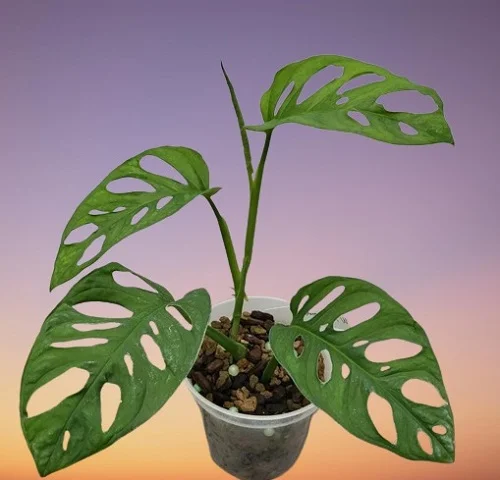
Monstera lechleriana bears fairly narrow, arrow-shaped leaves about 10 in. long with rounded holes close to the central rib of the leaf which start off entire but fenestrate as the plant matures.
Monstera lechleriana can grow to a height of 8 feet when provided with some form of support like a moss pole or trellis.
Monstera lechleriana grows best under bright light away from direct sunlight, warm and humid conditions and evenly moist, well-drained, fertile soil. Protect it from cold drafts.
17. Monstera acacoyaguensis

Monstera acacoyaguensis a fast growing plant whose leaves do not split but they perforate, leaving the entire leaf margin intact with large holes inside which occur at random.
Monstera acacoyaguensis can grow to a height of 6 feet if it is provided with a moss pole and the correct growing conditions as those in its natural environment in Central and South America.
Monstera acacoyaguensis thrives in bright indirect light away from direct sunlight, warm and moderately humid conditions and moist, fertile well-drained soil coupled with regular feeding.

